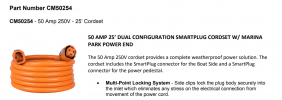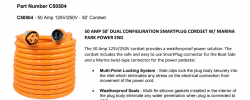scooper321
Well-Known Member
I posted this over in the 400DB forum but wanted to get a broader audience and comments.
Looking for experience on people that have replaced their Marinco shore power threaded inlets with Smart Plug inlets. I haven't seen any discussion about Smart Plug in this forum (Electronics) since middle of last year, so I'm wondering is the Smart Plug still a good option or is it now yesterday's news? I know it's been around for about 15 years or more, but doesn't seem to be getting more than cult following.
A recent insurance survey showed the very beginnings of some discoloration on one of the boat’s shoe power inlets. I’m not fooling around with this and so I'm looking to replace the inlet. Probably both of them (my boat has two 30A inlets).
The easiest soution would be to put new Marinco stainless inlets in. The inlets that are there are the white plastic ones and they are 20+ years old. So, not too shabby. Replacing them with new Marinco ones should get me 20 more years, right? So ... do I need to go to Smart Plug? I do inspect my power connections, so I'm wondering if it's overkill for a boater like me?
Sticking with Marinco, besides the inlets the only other expense would be new shore power cords for my home dock. My travel cords are relatively new and in good shape. So, all told, tis approach comes to about $200 per port. I could save a couple bucks by replacing just the power cord female connectors. I currently have the EEL connectors on there and I can’t seem to find them connectors on line anywhere. Does Marinco not sell them stand-alone for retrofit applications? If not, re-connectorizing my cord would mean using the locking ring style connectors. Some think that's more reliable than the EEL mechanism anyway. I’ve had both and never had an issue with the thread-on rings. The price difference is negligle in boat terms.
The big advantage of doing a Marinco replacement is that it's cheap, and I don’t need to modify or replace travel cords.
Smart Plug is a bit more expensive. Not just the components, but switching connection "ecosystems" means a bit more out of pocket. Switching to Smart Plug would require not only new inlets on the boat, but 4 new connectors that I would retrofit on both my home and travel shore power cord sets. This comes in at just under $400 per port. I could drive the cost even higher by buying completely new orange home dock SP cords. I'd still retrofit SP connectors on my travel cords.
I'm curious how secure the Smart Plug connection mechanism is... not just on Day 1 but after 5 years, 10 years? Does it hold the connections secure? Loose connections is THE main reason for charred inlets and connectors (and boat fires at the inlets). To my mind, the threaded connection seems to be the most secure option, but I like the larger contacts of the Smart Plug for minimal resistance.
I guess what I'm asking is ... who has the Smart Plug? How long have you had it and are you still happy with it? Did you find it to be worth the money? Yes, I know "it's worth it to prevent a fire". But if quality installation of the new Marinco parts and regular inspection of the connections will also prevent a fire, does the SP buy us anything additional? Is there any reason - other than cost - NOT to switch to Smart Plug?
Thanks,
Steve
Looking for experience on people that have replaced their Marinco shore power threaded inlets with Smart Plug inlets. I haven't seen any discussion about Smart Plug in this forum (Electronics) since middle of last year, so I'm wondering is the Smart Plug still a good option or is it now yesterday's news? I know it's been around for about 15 years or more, but doesn't seem to be getting more than cult following.
A recent insurance survey showed the very beginnings of some discoloration on one of the boat’s shoe power inlets. I’m not fooling around with this and so I'm looking to replace the inlet. Probably both of them (my boat has two 30A inlets).
The easiest soution would be to put new Marinco stainless inlets in. The inlets that are there are the white plastic ones and they are 20+ years old. So, not too shabby. Replacing them with new Marinco ones should get me 20 more years, right? So ... do I need to go to Smart Plug? I do inspect my power connections, so I'm wondering if it's overkill for a boater like me?
Sticking with Marinco, besides the inlets the only other expense would be new shore power cords for my home dock. My travel cords are relatively new and in good shape. So, all told, tis approach comes to about $200 per port. I could save a couple bucks by replacing just the power cord female connectors. I currently have the EEL connectors on there and I can’t seem to find them connectors on line anywhere. Does Marinco not sell them stand-alone for retrofit applications? If not, re-connectorizing my cord would mean using the locking ring style connectors. Some think that's more reliable than the EEL mechanism anyway. I’ve had both and never had an issue with the thread-on rings. The price difference is negligle in boat terms.
The big advantage of doing a Marinco replacement is that it's cheap, and I don’t need to modify or replace travel cords.
Smart Plug is a bit more expensive. Not just the components, but switching connection "ecosystems" means a bit more out of pocket. Switching to Smart Plug would require not only new inlets on the boat, but 4 new connectors that I would retrofit on both my home and travel shore power cord sets. This comes in at just under $400 per port. I could drive the cost even higher by buying completely new orange home dock SP cords. I'd still retrofit SP connectors on my travel cords.
I'm curious how secure the Smart Plug connection mechanism is... not just on Day 1 but after 5 years, 10 years? Does it hold the connections secure? Loose connections is THE main reason for charred inlets and connectors (and boat fires at the inlets). To my mind, the threaded connection seems to be the most secure option, but I like the larger contacts of the Smart Plug for minimal resistance.
I guess what I'm asking is ... who has the Smart Plug? How long have you had it and are you still happy with it? Did you find it to be worth the money? Yes, I know "it's worth it to prevent a fire". But if quality installation of the new Marinco parts and regular inspection of the connections will also prevent a fire, does the SP buy us anything additional? Is there any reason - other than cost - NOT to switch to Smart Plug?
Thanks,
Steve





